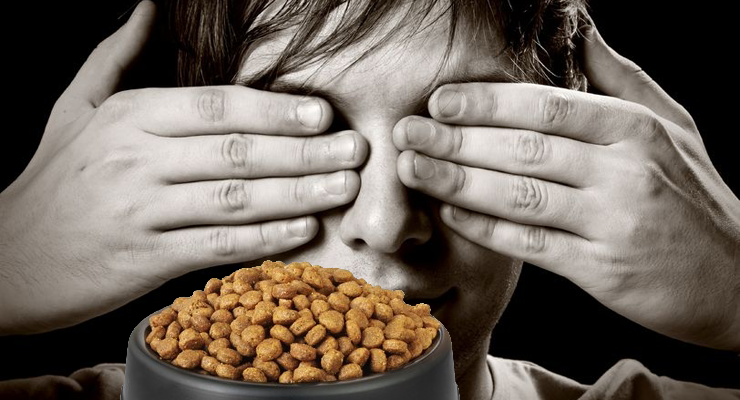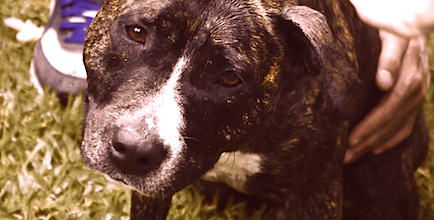Pet Food Secrets: What Brands Don’t Tell You About Ingredients and Quality
Commercial pet food is serious business. There are many viewpoints out there about what is best. Here are a few pet food secrets and things you may not know.

- 1. Animal fat could come from some unsavory places.
- 2. Fillers can be split up on the label to give the impression of a lower quantity.
- 3. The name on the bag isn’t always the actual manufacturer’s.
- 4. Veterinary endorsements don’t equal quality.
- 5. Preservatives may cause cancer.
- 6. Not all “people food” is bad.

Don’t leave your pet’s safety to chance
Sign up for Petful recall alerts today.

Pet food is a serious business, and opinions on what’s best vary widely. Choosing the right diet can feel overwhelming when faced with so many options, such as:
- A raw food diet, which some owners believe is more natural for pets.
- A grain-free diet, often marketed as a healthier alternative but not always necessary.
- A homemade pet food diet, which allows complete control over ingredients but requires careful planning.
- A convenience-first approach, where owners simply pick what’s available without considering nutritional impact.
While these diets differ, pet food secrets reveal some hidden truths that many commercial brands prefer to keep under wraps. Below are six key things most pet food companies don’t want you to know—along with insights that might surprise you.
The Truth About Animal Fat in Pet Food
Many pet food labels use generic terms like “animal fat,” but what does that really mean? The reality behind this vague ingredient might surprise you.
According to the Association of American Feed Control Officials (AAFCO), animal fat is defined as fat “obtained from the tissues of mammals and/or poultry in the commercial processes of rendering or extracting.” This broad definition leaves room for speculation—and concerns that it could include:
- Euthanized animals from shelters
- Slaughterhouse waste unfit for human consumption
- Roadkill and other unidentified sources
Unlike human food, pet food regulations are far less stringent. For example:
- The FDA does not require premarket approval for pet food, meaning products can be sold without strict safety checks.
- A controversial FDA statement suggests that using diseased or non-slaughtered animals in pet food is not a safety concern.
- AAFCO has no regulatory authority, and AAFCO’s labeling requirements do not guarantee transparency in pet food ingredients.
For a safer choice, look for pet food that lists specific meat sources such as chicken, beef, or turkey instead of vague terms like “animal fat” or “meat by-products.”
How Pet Food Labels Can Mislead You
Pet food labels can be deceptive, often making ingredients appear healthier or more balanced than they actually are. One common pet food secret involves ingredient splitting, a tactic used to make fillers seem like a smaller portion of the formula.
For example, a food containing 75% rice might be broken down into:
- 25% white rice
- 25% brown rice (Is brown rice good for dogs?)
- 25% rice gluten
By listing these separately, the company makes it seem like rice is less dominant in the formula. However, when combined, it remains the primary ingredient—far more than what most pets actually need.
Another labeling loophole involves the term “with” on packaging. According to AAFCO labeling guidelines, if a label says a food is “with chicken,” that protein only needs to make up at least 3% of the total product—far less than consumers might expect.
Because of these misleading tactics, it’s important to understand how to properly read ingredient labels. Educating yourself about pet food regulations can help you make better, more informed choices for your pet.
Who Really Makes Your Pet’s Food?
The brand name on a pet food bag doesn’t always tell the full story. Many pet food brands don’t manufacture their own products—instead, they rely on large third-party manufacturers.
For example, Diamond Pet Foods produces multiple brands, including:
- Apex
- Solid Gold
- Premium Edge
- Chicken Soup for the Pet Lover’s Soul
- Kirkland
- 4Health
- Taste of the Wild
Some companies are transparent about their manufacturers, while others—especially those with negative publicity or recall histories—may not disclose this information as openly. While details can be found, consumers often need to dig deeper to uncover which companies are responsible for making their pet’s food.
The Power Behind the Pet Food Industry
The pet food industry is a massive global business, valued at $151 billion USD and continuing to grow. Despite the wide variety of pet food brands available, most of this revenue is controlled by just a handful of major corporations.
According to Pet Food Industry, the top pet food companies generate billions in revenue each year. This market concentration means that even if you think you’re choosing between multiple brands, you’re often buying from the same few parent companies.
Being aware of who actually manufactures and owns your pet’s food brand can help you make more informed choices when selecting the best food for your pet.

Do Veterinary Endorsements Guarantee Quality?
Many pet food brands use labels like “Veterinarian Recommended,” “Veterinarian Formulated,” or “Veterinarian Developed” to gain consumer trust. However, these phrases don’t always indicate superior quality—and they shouldn’t be the sole reason to choose a pet food brand.
Here’s why:
- Lack of transparency – Some brands don’t disclose which veterinarian is endorsing their product, making it unclear if the recommendation comes from a trusted expert or a paid endorsement.
- Marketing over science – Just because a product claims veterinary involvement doesn’t mean it meets the highest nutritional standards. Always check the ingredient list and nutritional profile.
- No regulatory approval – According to AAFCO guidelines, pet food companies cannot use the phrase “Veterinarian Approved.” This is because veterinarians do not have the legal authority to approve food—that power belongs to state and federal agencies.
How to Choose a Truly High-Quality Pet Food
Instead of relying on vague veterinary endorsements, pet owners should:
- Examine the ingredient list for whole, high-quality protein sources.
- Look for AAFCO nutritional adequacy statements that indicate the food meets recognized standards.
- Research independent reviews from unbiased sources before purchasing.
While veterinarians play an essential role in pet health, their endorsements on pet food packaging can sometimes be more about marketing than quality. Always verify claims and prioritize transparent, high-quality ingredients when choosing the best food for your pet.
Can Preservatives in Pet Food Increase Cancer Risk?
Pet food labels can be confusing, especially when it comes to preservatives. One common additive, butylated hydroxyanisole (BHA), is used to extend shelf life—but its safety remains controversial.
- BHA is classified as “generally safe in low doses” by the FDA.
- However, it appears on California’s Proposition 65 list as a chemical known to cause cancer in lab studies.
- Though pet food contains BHA in small amounts, long-term exposure is a concern, given that pets consume food daily.
Should You Avoid Pet Food with Preservatives?
While preservatives help prevent spoilage, some are linked to potential health risks. To minimize exposure:
- Look for pet food brands that use natural preservatives like tocopherols (Vitamin E) or ascorbic acid (Vitamin C).
- Check ingredient labels for BHA, BHT, or ethoxyquin—preservatives with questionable safety profiles.
- Consider fresh or minimally processed pet food to reduce artificial additives.
Although research on the long-term effects of preservatives in pet food is ongoing, being cautious about what your pet eats can help reduce unnecessary risks.
Not All “People Food” Is Bad for Pets
Many pet owners have heard that feeding their pets human food is dangerous. While some foods are toxic—such as chocolate, grapes, raisins, onions, and garlic—others can actually be beneficial.
The Benefits of Homemade Pet Food
Making pet food at home allows you to:
- Control ingredient quality and avoid harmful additives.
- Use fresh meats and vegetables that provide natural nutrition.
- Potentially save money, depending on ingredient choices.
For example, dogs can safely enjoy certain vegetables as part of a balanced diet. However, homemade meals require proper planning to ensure nutritional balance.
The Risks of Home-Cooked Pet Meals
Many pet owners assume they can simply mix meat, grains, and supplements to create a complete meal, but nutritional balance is more complex than it seems. Dr. Debora Lichtenberg, VMD, warns:
“If you thought you could just throw some chicken and brown rice together, change up the veggies from time to time, throw in a vitamin and some calcium, and go feed Mr. Tibbs a meal made for a dog-king, think again.”
How to Ensure Proper Nutrition
Before switching to homemade pet food:
- Consult with a veterinarian or pet nutritionist to create a balanced meal plan.
- Follow scientifically backed recipes, such as those in this guide to home-cooked pet food.
- Avoid toxic foods by checking this list of harmful ingredients.
Final Thoughts
Understanding pet food secrets isn’t just about commercial brands—it’s also about knowing what makes a diet truly nutritious. Reading labels carefully and researching pet nutrition can help ensure your pet gets the best possible diet, whether store-bought or homemade.
Frequently Asked Questions (FAQ)
What is the 80/20 rule for dog food?
The 80/20 rule for dog food suggests that 80% of a dog’s diet should come from nutritionally complete meals, while 20% can include healthy extras like fresh meats, vegetables, or treats.
Why is pork not used in pet food?
Pork is rarely used in pet food due to concerns over fat content, potential parasites like trichinella, and religious or cultural considerations in some markets.







